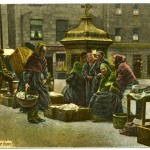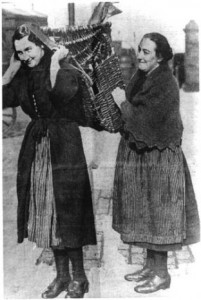From the 1700s to the 1980s women took fish from the ports, carrying them in various baskets to the towns to sell either door to door or by setting up stalls. In later times some of them used trains and trams. These women were often called fishwives or fisherlassies. They were selling white fish, the sea bottom feeders which were caught using long line fishing techniques. This work brought an independence for women with their own money coming in.
Starting at Thurso we have a photo of a fishwife’s basket. They also use large round frame basket also with handles.
Down now to the Aberdeen area, we know that women brought fish from many of the surrounding villages to the north and south of the town, even as far as Newburgh, 15 miles distant.
The area of Montrose, Arbroath, Dundee and associated villages, including Auchmithie, Ferryden, Usan, Johnshaven and Ethie Haven, had a huge fishing industry. Women in this area used ‘rips ‘and arm creels to carry and display the fish. Liz Balfour notes that the fish sellers always used the front door when selling door to door, not the tradesman’s entrance. Women had their usual round of customers and would gut the fish on a board for the customer at the door. Keeping the fish whole till this point kept it fresher. The rips were not used at the harbour, only by the women sellers. These rips were carried on the back with a strap around the chest, or with the strap over the shoulder. The arm or bow creel could be put on top of the rib if not carried over one arm. These women had their own particular style of dress inspired by Dutch costume with brightly striped petticoats.
The area of Edinburgh, included many fishing ports including Newhaven, Fisherrow, Corstophine. women in this area used creels with a deep round scull on top. Newhaven fishwives used a canvas strap and Fisherrow women used a leather one. These straps were worn around the forehead. The weight of the creel and scull were such that these women would help each other to get them set on their back. The fish were stored in the scull with the board, knife, paper, scales and a bag for personal items, such as knitting, in the creel. If she was carrying any smoked fish these would go in the creel too. The women would buy the fish at the port, sometimes clubbing together to buy a larger amount. Then this would be piled into equal shares. Someone else would be asked to assign them to each woman to ensure all was fair. This was known as ‘kyling’. Some women would sell at the pierhead itself. It was a Fisherrow fishwife, Betty Millar who is the last known fishwife, only retiring in 1988. In her later years she had a stall rather than walking door to door and then she used a van.
The baskets used by these women may have started off being made in willow but when the more salt resistant cane started arriving in the ports, the basketmakers soon changed over. The women would have needed very strong baskets and as long lasting as possible.
By Dawn Susan




